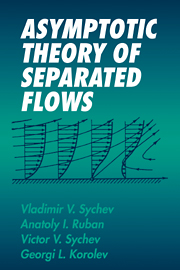Book contents
- Frontmatter
- Contents
- Preface
- Preface to the English Edition
- 1 The Theory of Separation from a Smooth Surface
- 2 Flow Separation from Corners of a Body Contour
- 3 Flow in the Vicinity of the Trailing Edge of a Thin Airfoil
- 4 Separation at the Leading Edge of a Thin Airfoil
- 5 The Theory of Unsteady Separation
- 6 The Asymptotic Theory of Flow Past Blunt Bodies
- 7 Numerical Methods for Solving the Equations of Interaction
- References
- Index
Preface
Published online by Cambridge University Press: 07 October 2011
- Frontmatter
- Contents
- Preface
- Preface to the English Edition
- 1 The Theory of Separation from a Smooth Surface
- 2 Flow Separation from Corners of a Body Contour
- 3 Flow in the Vicinity of the Trailing Edge of a Thin Airfoil
- 4 Separation at the Leading Edge of a Thin Airfoil
- 5 The Theory of Unsteady Separation
- 6 The Asymptotic Theory of Flow Past Blunt Bodies
- 7 Numerical Methods for Solving the Equations of Interaction
- References
- Index
Summary
The major successes achieved since the late 1960s in the development of the theory of separated flows of liquids and gases at high Reynolds numbers are in many respects associated with the use of asymptotic methods of investigation. The most fruitful of these has proved to be the method of matched asymptotic expansions, which has also become widely used in many other fields of mechanics and mathematical physics (Van Dyke, 1964, 1975; Cole, 1968; Lagerstrom and Casten, 1972). By means of this method, important problems have been solved concerning boundary-layer interaction and separation in subsonic and supersonic flows, the nature of these phenomena has been made clear, and basic laws and controlling parameters have been ascertained. The number of original papers devoted to different problems in the asymptotic theory of separated flows now amounts to many dozens. We can confidently speak of the appearance of a new and very productive direction in the development of theoretical hydrodynamics. However, it has not yet received an adequate systematic account, and the objective of this book is to make an attempt to partially fill this gap.
Of necessity, the authors have restricted themselves to consideration of a range of problems most familiar to them, associated with two-dimensional separated flows of an incompressible fluid, assumed to be laminar. Thus, the book excludes the results of many investigations of separated gas flows at transonic, supersonic, and hypersonic speeds, although chronologically the problem of boundary-layer separation in supersonic flow was solved earlier than the others (see Chapter 1).
Here we leave completely untouched the study of turbulent boundary-layer interaction and separation, as well as the large class of problems of internal flows in channels and tubes.
- Type
- Chapter
- Information
- Asymptotic Theory of Separated Flows , pp. vii - ixPublisher: Cambridge University PressPrint publication year: 1998

